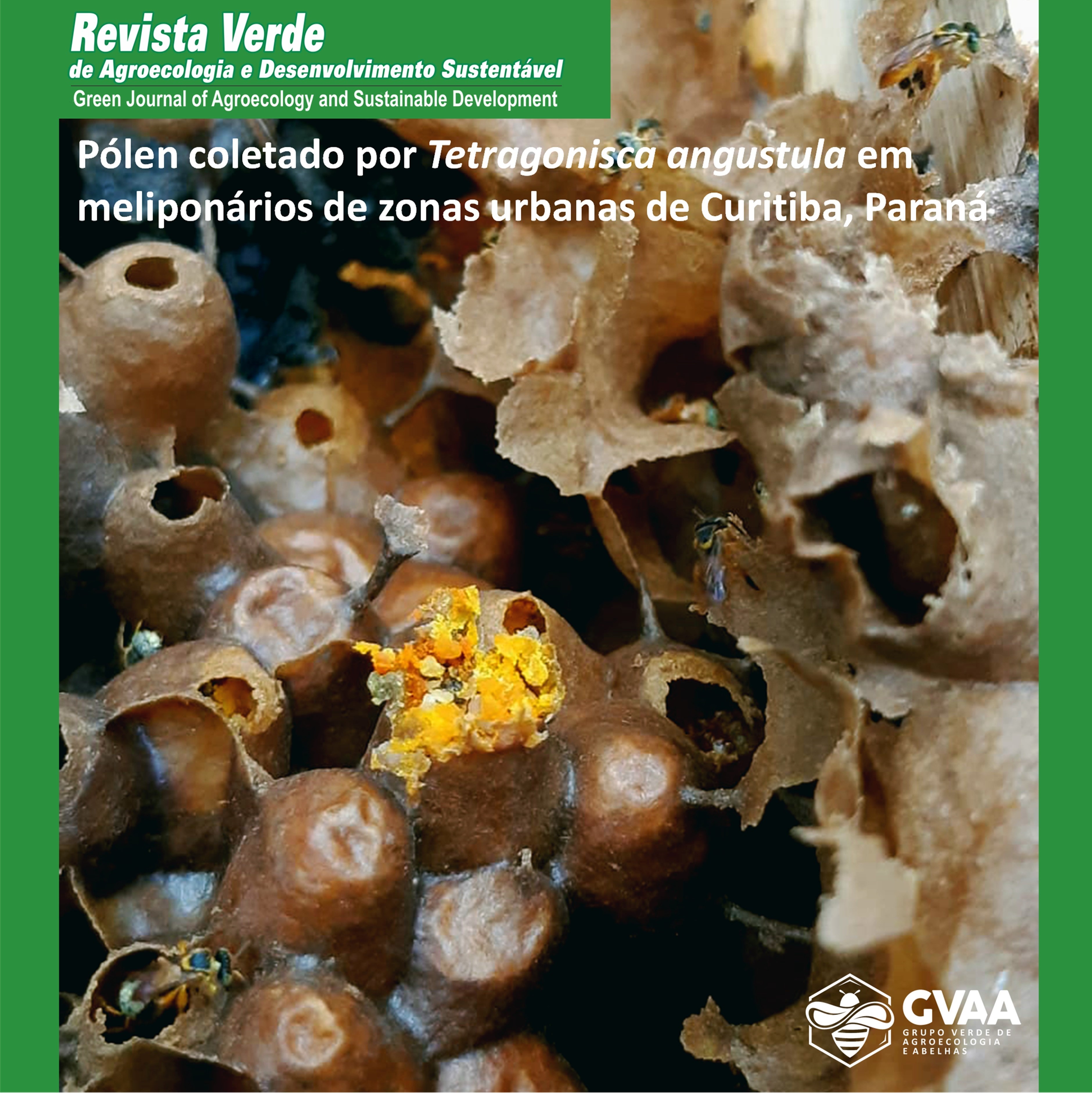Pollen collected by Tetragonisca angustula in meliponaries from urban areas of Curitiba, Paraná, Brazil
DOI:
https://doi.org/10.18378/rvads.v16i3.8162Keywords:
Native bees, Jataí, Pollen analysisAbstract
Pollen grains collected by bees can serve as a tool for identifying plant species, as well as helping to establish the relationship between pollinators and the local flora. This research aimed to analyze the botanical profile of pollen from the native bee Tetragonisca angustula (jataí) and identify which plants are visited by them. Pollen was collected from the food pots inside the hives from the honey gardens of Curitiba, PR, in two different points of the municipality. The samples were prepared by the acetolysis method, followed by assembly and observation of semi-permanent slides under an optical microscope. Taxonomic identification of pollen grains was carried out with the aid of articles and a palynological database. The qualitative analysis resulted in the observation of 16 types of pollen grains, belonging to the families Acanthaceae, Asteraceae, Amaranthaceae, Brassicaceae, Cannaceae, Fabaceae, Loranthaceae, Myrtaceae, Malvaceae, Poaceae e Solanaceae. The identified pollen originated from native species, corroborating the relationship between the native flora and the stingless bees. Results displalyed a significant difference between the pollen richness of the two study sites, suggesting that one of them, the General Osório square, has little diversity in its afforestation, thus having fewer visitation options for the bees residing this meliponary.
Downloads
References
BRAGA, J. A.; SALES, E. O.; NETO, J. S.; CONDE, M. M.; BARTH, O. M.; LORENZON, M. C. Floral sources to Tetragonisca angustula (Hymenoptera: Apidae) and their pollen morphology in a Southeastern Brazilian Atlantic Forest. Revista de Biologia Tropical, v. 60, n. 4, p. 1491-1501, 2012. https://doi.org/10.15517/RBT.V60I4.2067.
BRIZOLA-BONACINA, A. K.; ARRUDA, V. M.; ALVES-JUNIOR, V. V.; CHAUD-NETO, J.; POLATTO, L. P. Bee Visitors of Quaresmeira Flowers (Tibouchina granulosa Cogn.) in the Region of Dourados (MS-Brasil). Sociobiology, v. 59, n. 4, p.1253-1267, 2012. https://doi.org/10.13102/sociobiology.v59i4.503.
CARVALHO, C. A. L.; MARCHINI, L. C. Tipos polínicos coletados por Nannotrigona testaceicornis e Tetragonisca angustula (Hymenoptera, Apidae, Meliponinae). Scientia Agrícola v. 56, n. 3, p. 1-8, 1999. https://doi.org/10.1590/s0103-90161999000300029.
CNCFlora. Centro Nacional de Conservação da Flora. 2013. Disponível em < http://www.cncflora.jbrj.gov.br/portal> Acesso em 22 de maio de 2019.
CORREIA, F. C. da S.; FRANCISCO, R. da S.; PERUQUETTI, R. C. Palinologia e a interação planta-abelha: revisão de literatura. Arquivos de Ciências Veterinárias e Zoologia, v. 20, n. 4, p. 247-251, 2017. https://doi.org/10.25110/arqvet.v20i4.2017.5221
ESALQ/USP, Banco de imagens de polens de Plantas Apícolas do laboratório de insetos úteis entomologia da Universidade de São Paulo. 2018. Disponível em <http://www.lea.esalq.usp.br/polen/> Acesso em: 22 de maio de 2019.
ERDTMAN, G. The acetolysis method: a revised description. Svensk Botanisk Tidskrift, Uppsala, v.54, p. 561-564, 1960.
GONÇALVES, R. B.; SOUZA, J. M.; NEVES, C. M. L. Abelhas (Hymenoptera) da Reserva Biológica de Pedra Talhada. In: Studer, A., L. Nusbaumer & R. Spichiger (Eds.). Biodiversidade da Reserva Biológica de Pedra Talhada (Alagoas, Pernambuco - Brasil), Boissiera, cap. 68, p. 291-298, 2015.
IPPUC - Instituto de Pesquisa e Planejamento Urbano de Curitiba. Mapas. 2018. Disponível em: <https://www.ippuc.org.br/> Acesso em: 30 de agosto de 2021.
IWAMA, S.; MELHEM, T. S. The pollen spectrum of the honey of Tetragonisca angustula Latreille (APIDAE, MELIPONINAE). Apidologie, v. 10, n. 3, p. 275-295, 1979. https://doi.org/10.1051/apido:19790305
LEITE, F. T.; LEITE, C. T.; SOUZA, L.; CARRIJO, T. T. Tipos polínicos coletados por Tetragonisca angustula (Latreille, 1811) em um fragmento de floresta atlântica no Espírito Santo. Acta Scientiae & Technicae, v. 3, n. 1, p.1-8, 2015. https://doi.org/10.17648/uezo-ast-v3i1.80.
LORENZON, M. C.; MORADO, C. N. A abelha Jataí: flora visitada na Mata Atlântica. 1st. edn. Rio de Janeiro, Letras e Versos, 2014. 122p.
LORENZON, M. C.; CONDE, M. M. As fontes florais forrageadas por abelhas eussociais (Apidae) em fragmentos da Ilha Grande. In: LORENZON, M. C.; MORADO, C. N. A abelha Jataí: flora visitada na Mata Atlântica. 1st. edn. Rio de Janeiro, Letras e Versos, 2014. 122p.
MORGADO, L. N.; ANDRADE, R. C.; LORENZON, M. C. A.; GONÇALVES-ESTEVES, V. Padrão polínico utilizado por Tetragonisca angustula Latreille (Apidae: Meliponina). Acta Botanica Brasilica, v. 5, n. 4, p. 932-934, 2011. https://doi.org/10.1590/S0102-33062011000400021.
MORGADO, L. N.; RESENDES, R.; VILLANUEVA, R. S.; MOURA M.; VENTURA, M. A. M. Palinologia uma importante ferramenta em diferentes áreas científicas. Açoriano Oriental, Açores Magazine, UAciência, p. 26-27, 2013.
NOGUEIRA-NETO, P. Vida e Criação de Abelhas indígenas sem ferrão. São Paulo: Editora Nogueirapis, 1997. 445 p.
NOVAIS, S. J.; GARCÊZ, A. C.; ABSY, M. L.; SANTOS, F. A. R. Comparative pollen spectra of Tetragonisca angustula (Apidae, Meliponini) from the Lower Amazon (Brazil) and caatinga (NE Brazil). Apidologie, v. 46, p 417-431, 2014. https://doi.org/10.1007/s13592-014-0332-z.
PEREIRA, J. S. Análise palinológica forense em tecidos de voluntários humanos. 2017. 74f. Tese (Mestrado em Ciências Forense), Universidade do Porto, Porto, 2017.
RCPOL, Rede de catálogos polínicos online. 2013. Disponível em <http://chaves.rcpol.org.br/eco> Acesso em 13 de março de 2019.
REFLORA. Flora do Brasil 2020. Disponível em <http://reflora.jbrj.gov.br/reflora/listaBrasil/PrincipalUC/PrincipalUC.do#CondicaoTaxonCP> Acesso em: 22 de julho de 2019.
SANTOS, A. B. Abelhas nativas: polinizadores em declínio. Natureza on line, v. 8, n. 3, p.103-106, 2010. Disponível em <http://www.naturezaonline.com.br/natureza/conteudo/default.asp?volume=8&numero=3> Acesso em: 30 de agosto de 2021.
SILVA, W. P.; PAZ, J. R. L. Abelhas sem ferrão: muito mais do que uma importância econômica. Natureza on line, v. 10, n.3, p. 146-152. 2012.
ULBRA. Laboratório de Palinologia da ULBRA. Disponível em < http://sites.ulbra.br/palinologia/index1.htm> Acesso em: 22 de maio de 2019.
UTFPR, Banco de imagens de grãos de pólen, fitólitos e espículas de esponjas da Universidade Tecnológica Federal do Paraná. 2010. Disponível em <http://www.fecilcam.br/lepafe/palinoteca/> Acesso em: 08 de março de 2019.
VILLAS-BÔAS, J. Manual Tecnológico: Mel de Abelhas sem Ferrão. 1. ed. Brasília, Instituto Sociedade, População e Natureza (ISPN), 2012. 96p.
WOLOWSKI, M.; AGOSTINI, K.; RECH, A. R; VARASSIN, I. G.; MAUÉS, M.; FREITAS, L.; CARNEIRO, L. T.; BUENO, R. de O.; CONSOLARO, H.; CARVALHEIRO, L.; SARAIVA, A. M.; SILVA, C. I. Relatório temático sobre polinização, polinizadores e produção de alimentos no Brasil. São Carlos, SP: Editora Cubo, 2019. 93p.











